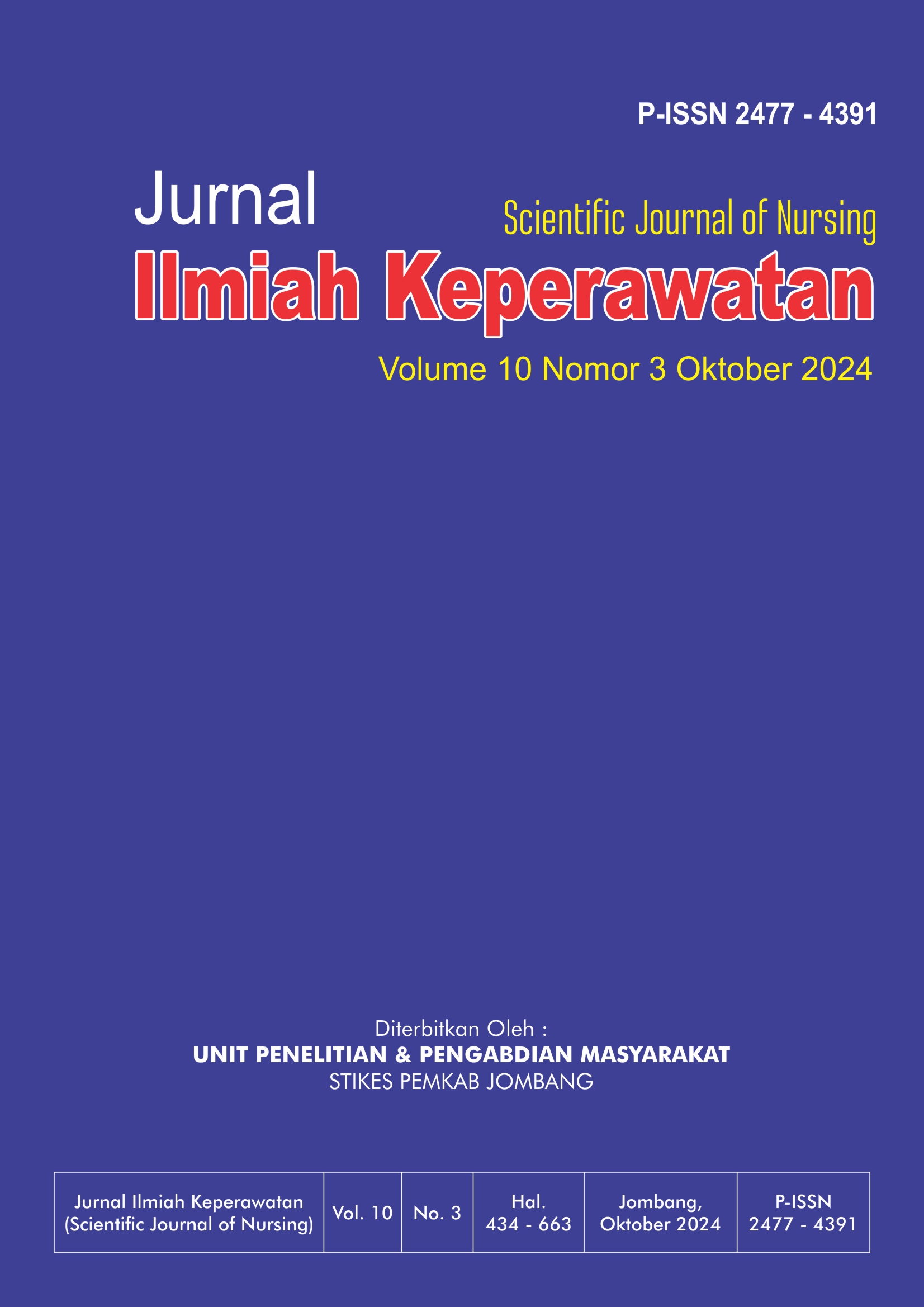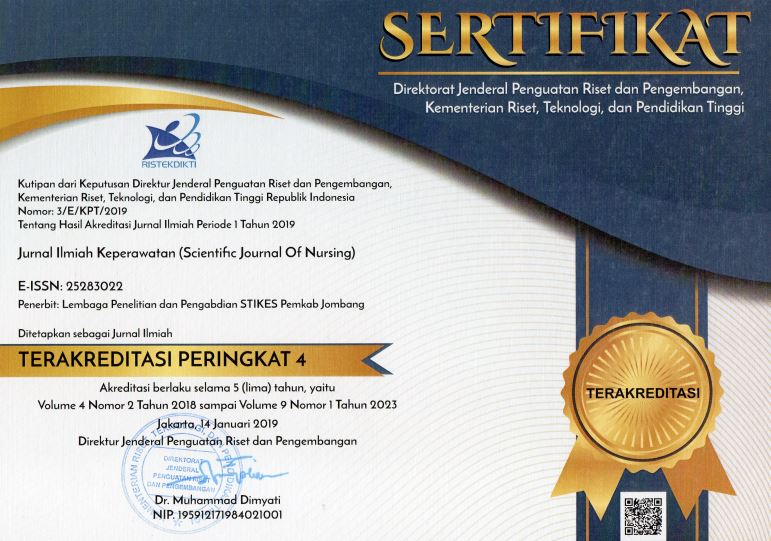MANFAAT BRAIN GYM UNTUK MENINGKATKAN KESEIMBANGAN PADA ANAK SEKOLAH DASAR
Benefits of Brain Gym to Improve Balance in Elementary School Children
DOI:
https://doi.org/10.33023/jikep.v10i3.2268Keywords:
Brain gym, Keseimbangan, Sekolah DasarAbstract
Pendahuluan: Keseimbangan adalah komponen biomotorik esensial yang penting untuk mengatur posisi dan gerakan tubuh, serta mendukung aktivitas fisik dan olahraga. Brain Gym adalah metode latihan yang efektif dalam meningkatkan keseimbangan dan koordinasi gerakan dengan meningkatkan sirkulasi darah dan oksigen ke otak. Tujuan: mengidentifikasi manfaat brain gym terhadap keseimbangan tubuh pada pada anak sekolah dasar. Metode: penelitian ini menggunakan desain Quasi eksperimen dengan pretest-posttest, melibatkan 23 pasien yang mengikuti brain gym selama 15 menit selama 6 hari berturut-turut. Pengukuran keseimbangan dilakukan dengan stopwatch, dan data dianalisis menggunakan uji Wilcoxon setelah uji normalitas menggunakan Shapiro-wilk. Hasil: analisa data menggunakan uji Wilcoxon antara sebelum dan sesudah perlakuan didapatkan nilai hasil Asymp. Sig. ,000 yang berarti nilai p<0,05 maka H0 ditolak dan Ha diterima. Kesimpulan: ada pengaruh brain gym terhadap peningkatan keseimbangan pada anak sekolah dasar.
Downloads
References
B?aszczyk, J. W., Artur Fredyk, P. M. B., & Ashtiani, M. (2020). Step Response of Human Motor System as a Measure of Postural Stability in Children. IEEE Transactions On Neural Systems And Rehabilitation Engineering, 28(4), 1–9.
Çetin, O., Beylero?lu, M., Ba???, Y. E., & Suna, G. (2018). The effect of the exercises brain on boxers’ eye-hand coordination, dynamic balance and visual attention performance. Physical Education of Students, 22(3), 112. https://doi.org/10.15561/20755279.2018.0301
Facco Alves, R., Garcia Rossi, A., Ivan Pranke, G., & Fernando Cuozzo Lemos, L. (2013). Influence of Gender in Postural balance of School Age Children. Rev. CEFAC, 15(3), 528–536.
Granacher, U., Muehlbauer, T., & Gollhofer, L. M. L. Z. A. (2011). Can Balance Training Promote Balance and Strenght in Prepubertal Children? Journal of Strenght and Conditioning Research, 25(6), 1759–1766.
Indri sarwli, W., Kasih Pasaribu, Y., & Herliana, I. (2021). Brain Gym Dapat Meningkatkan Keseimbangan Tubuh Pada Remaja. Open Access Jakarta Journal of Health Sciences, 1(2), 72–77. https://doi.org/10.53801/oajjhs.v1i3.18
Kartiyani, T., & Subroto, W. (2016). Perbedaan pengaruh latihan pilates dengan latihan wobble board terhadap keseimbangan ditinjau dari jenis kelamin pada remaja. Jurnal Kesehatan Al-Irsyad, (2):81–7.
Larashati, N. P. D., Sundari, L. P. R., Wahyuddin, & Adiputra, L. M. I. S. H. (2024). Brain Gym and Core Stability Exercises are Superior in Improving Dynamic Balance in 8-9-Year-Old Children. 19(5), 1–23. https://doi.org/https://doi.org/10.24843/mifi.2024.v12.i02.p02
Larashati, N. P. D., Sundari, L. P. R., Wahyuddin, Adiputra, L. M. I. S. H., Iswari, I., & Tianing, N. W. (2024). Brain Gym and Core Stability Exercises are Superior in Improving Dynamic Balance in 8-9-Year-Old Children. Majalah Ilmiah Fisoterapi Indonesia, 12(2), 134–140.
Larashati, N. P. D., Tianing, N. W., & Muliarta, I. M. (2018). The Brain Gym In Core Stability Exercise Is Increase The Dynamic Balance Among Children 7 To 8 Years Old At Ppa Tunas Kasih Abianbase. 5(1), 35–38.
Melo, R. de S., Marinho, S. E. D. S., Freire, M. E. A., Souza, R. A., Damasceno, H. A. M., & Raposo, M. C. F. (2017). Static and dynamic balance of children and adolescents with sensorineural hearing loss. Einstein (Sao Paulo, Brazil), 15(3), 262–268. https://doi.org/10.1590/S1679-45082017AO3976
Mickle, K. J., Munro, B. J., & Steele, J. R. (2011). Gender and age affect balance performance in primary school-aged children. Journal of Science and Medicine in Sport, 14(3), 243–248. https://doi.org/10.1016/j.jsams.2010.11.002
Nafarin, M. F. (2016). Pengaruh Senam Otak Terhadap Keseimbangan Dinamis pada Anak Usia 7-8 Tahun di SD Negeri Pabelan 03MendunganKartasuraSukoharjo. Naskah Publikasi, 2(2):1–18.
Olszewska, E. (2024). Static and dynamic balance in children in the context of school readiness. Journal of Bodywork and Movement Therapies, 40(May), 921–925. https://doi.org/10.1016/j.jbmt.2024.05.031
Panjan, A., & Sarabon, N. (2012). Review of Methods for the Evaluation of Human Body Balance. Sport Science Review, 19(5–6), 131–163. https://doi.org/10.2478/v10237-011-0036-5
Rahman, D., & Hakim, A. A. (2022). Pengaruh modifikasi aktifitas fisik keseimbangan terhadap keterampilan motorik anak usia dini pada masa adaptasi kehidupan baru. Jurnal Kesehatan Olahraga, 10(01), 197–204.
Rohana, S. (2011). Senam Vitalisasi Otak Lebih Meningkatkan Fungsi. Jurnal Fisioterapi, 11(1), 15–35.
Siamy, H. A. (2015). Senam Otak Lebih Meningkatkan Keseimbangan Dinamis Daripada Senam Kesegaran Jasmani. Sport and Fitness Journal, 3(3), 26–37.
Veiskarami, P., & Roozbahani, M. (2020). Motor development in deaf children based on gallahue’s model: A review study. Auditory and Vestibular Research, 29(1), 10–25. https://doi.org/10.18502/avr.v29i1.2364
Published
How to Cite
Issue
Section
Authors who publish with Jurnal Ilmiah Keperawatan (Scientific Journal of Nursing) agree to the following terms:
- Authors retain copyright and grant Jurnal Ilmiah Keperawatan (Scientific Journal of Nursing) the right of first publication with the work simultaneously licensed under a Creative Commons Attribution 4.0 International License that allows others to remix, adapt and build upon the work with an acknowledgment of the work's authorship and of the initial publication in Jurnal Ilmiah Keperawatan (Scientific Journal of Nursing).
- Authors are permitted to copy and redistribute the journal's published version of the work (e.g., post it to an institutional repository or publish it in a book), with an acknowledgment of its initial publication in Jurnal Ilmiah Keperawatan (Scientific Journal of Nursing).











